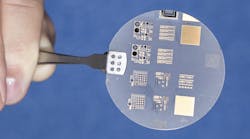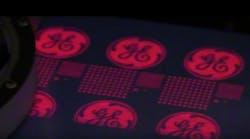Researchers at Peking University (Beijing, China) are crafting phosphor-free gallium nitride-based white LEDs that rely on a "strain adjusting" indium gallium arsenide (InGaN) interlayer to produce blue and yellow luminescence.
While this isn't the first time such an LED has been made, the researchers have carefully studied the origin of the luminescence, determining that it arises from the high-indium core (yellow emission) and adjacent indium-depleted regions (blue emission) in inverted pyramidal pits on the LED's surface.1 The pits are formed when the strain-relaxation process induces dislocations in the InGaN interlayer.
The properties of the white LED were studied by measuring room-temperature electroluminescence (EL) and cathodoluminescence spectra, while high-resolution x-ray diffraction and scanning-electron microscopy were used to help understand the relationship between the device's structure and its optical properties.
When the injection current is low, the LED emits mainly yellow (560 nm) light. As the injection current increases, the blue (466 nm) portion of the emission increases, and the yellow portion eventually saturates. For example, at a current of 50 mA, the LED is yellow, but when the current is raised to 150 mA, the EL spectrum corresponds to a white-light source with a color temperature of 4972 K and CIE chromaticity-diagram coordinates of 0.30, 0.37.
Ordinary white LEDs produce their light by a combination of blue LED emission and downconverted yellow light emanating from a phosphor, which is stimulated by a portion of the blue LED light. If a strain-adjusted (non-phosphor-containing) LED could be made to be as efficient as an ordinary white LED, it could very well become the new standard for white LEDs. The reason? It would likely last longer, as there is no phosphor to degrade.
1. H. Fang et al., Applied Physics Letters 93, 261117 (published online December 31, 2008).
--John Wallace




